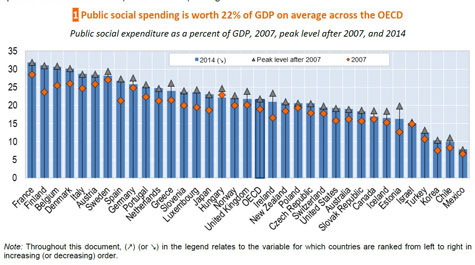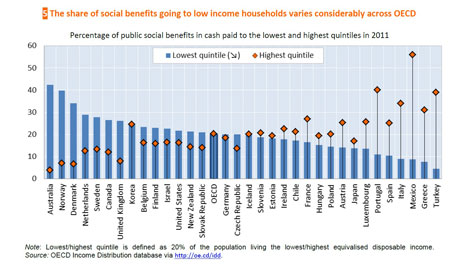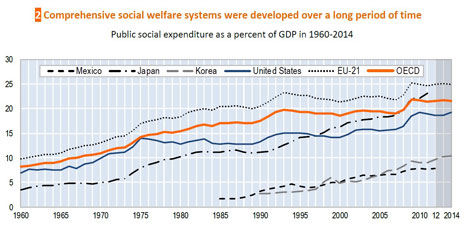A closer look at the American welfare state with a W&M social policy expert
Although America’s social welfare system may be lacking in relative size, it more than makes up for it with its complexities, according to Christopher D. Howard, William & Mary’s Pamela C. Harriman Professor of Government and Public Policy.
Howard has spent the past 25 years researching and teaching classes on the unique aspects of America’s welfare state. He has found that while the United States’ system is still significant in size, what makes it different from the rest of the world is the implementation of specific strategies such as using the American tax code to drive social policy in maintaining social programs at the federal level.
“What is unusual about our system is our public-private mix, and the broad range of policy tools we as a nation employ,” he said. “Our welfare state relies a lot on programs that are funded by the government, but private or non-profit actors provide the benefits. We create huge tax breaks so that companies will provide pensions and health insurance to their workers. As far as policy tools, we do use social insurance, which is a hallmark of the modern welfare state. But we as a nation also use tax expenditures or social regulations such as minimum wage laws or policies such as the Family and Medical Leave Act more than most other countries.”
History of the welfare state
According to the Disability History Museum, the welfare state in America as a concept goes as far back as early as the 1600s when the United States was just a combination of a few settlements under the rule of Great Britain. But the welfare state today is attributed to 19th century Germany, according to Howard.
“Germany is usually credited with being the first modern welfare state,” he said. “The country’s government pioneered social insurance for the sick and elderly in the late 1800s, under [Otto Von] Bismarck as the nation’s chancellor. Countries around the world have cared for their poor long before this time, usually at the local level. However, the model ‘welfare state’ is usually defined by actions taken at the national level, and that started with Germany.”
For the United States, that began in 1935 with the passage of former President Franklin D. Roosevelt’s Social Security Act under his “New Deal” for America, according to the Library of Congress.
Although the reasoning behind the Social Security Act of 1935 was to provide monetary assistance to Americans for the long-term, Roosevelt’s real aim was to try and provide immediate relief for Americans adversely affected by the Great Depression, said Howard.
“There were a couple of programs the Roosevelt administration immediately implemented,” he said. “What was then called ‘Old Age Assistance’ was meant to provide cash benefits to the nation’s poor elderly which we now know as Supplemental Security Income. Secondly, the Roosevelt administration put into effect a program called ‘Aid to Dependent Children’ which is what we would call today, ‘welfare.’ Its intentions were to help provide assistance to children of poor single parent families. And due to the millions of people who were without jobs, the creation of unemployment insurance was another immediate policy that the Roosevelt administration implemented.”
Since its inception, the American welfare state has gone about many changes. Those changes include the increase in funding for federal programs and subsidies given to employers throughout the country, according to Howard.
“The way to think about the growth of the American welfare state is like this,” he said. “We’ve had two ‘big bangs.’ The first beginning in the 1930s and the second in the mid-1960s. Social Security starts out in 1935 as a small program, but it gradually and deliberately expands. And as time passes we see a big jump in private companies offering their own types of social ‘safety nets.’”
Those “safety nets” according to Howard were the federal government’s creation of disability insurance and the levying of substantial tax breaks for employers who offered their employees private retirement pensions and private health insurance.
Taxes and social policy
Although many social and political science experts study the history of welfare, Howard’s research is unique among that of social scientists in that it has focused on the relationship between the tax code and the welfare state.
“The tax code is used to make social policy,” he said. “Often there are programs or policies like tax expenditures, or what some people would call tax breaks or tax loopholes. On many occasions, these small amendments were slipped into larger tax legislations. And by doing so, social policy is created without any real deliberate consideration by Congress or the president.”
As to whether or not these amendments work, Howard said that the American government does not necessarily track the overall effectiveness of these tax breaks, so the data is limited.
“Most economists will tell you that an ideal tax code has few if any tax expenditures,” he said. “These tax breaks often reward people for actions they would have taken anyway such as purchasing a home, lead people to over-invest in tax-favored goods and provide benefits to the most affluent. Interestingly, the U.S. government rarely if ever evaluates how well these tax expenditures work. What we do know comes largely from economists outside of government, and they are usually pretty critical of these tax breaks.”
However, Howard does note that there is a particular case that the tax code is not used to drive social policy.
“The Earned Income Tax Credit is a notable exception,” he said. “The benefits go exclusively to low-income families, and the tax credit rewards work, not the purchase of a specific good like health insurance or housing.”
Howard’s research has found that welfare systems of other countries around the world try their best to adapt to the changing aspects of their societies. These changes could be the nation's infrastructure diverging from manufacturing to technologically-based jobs or a shift in social norms such as having an increase in two-income families. However, some nations have had difficulties adjusting to these changes, according to Howard.
“In [the United States], for instance, we haven’t moved very quickly to help families where both parents work outside the home,” said Howard. “The United States is one of the very few countries in the world without paid parental leave, and our child care policies leave a lot to be desired. We’re also not moving very decisively to deal with the gradual erosion of health and pension benefits offered by private companies.”
The future of the welfare state
As to the outlook of the American welfare state, Howard’s research indicates that when it comes to the social welfare system of any nation, there will always be the need for possible improvements. The reason behind this is because, at some point in their life, many Americans may have to use one or more of the nation’s social programs, according to Howard.
“Virtually [every American] will benefit at some point in their lives, and will use the nation’s social programs,” he said. “For example, as a child, you might benefit from Medicaid or Food Stamps, and as a parent, you might take advantage of the Child Tax Credit or the Earned Income Tax Credit.
“And what I try and teach my students is for them to objectively look at what is the most pressing and least pressing issues concerning our current social welfare system. Whether that be healthcare as a whole or the benefit formulas that the government uses to calculate what’s distributed to people applying for aid, there will always be room for improvement.”
Howard recently finished a guide to research methods for undergraduates, “Thinking Like a Political Scientist: A Practical Guide to Research Methods,” which will be published by the University of Chicago Press in March.



















